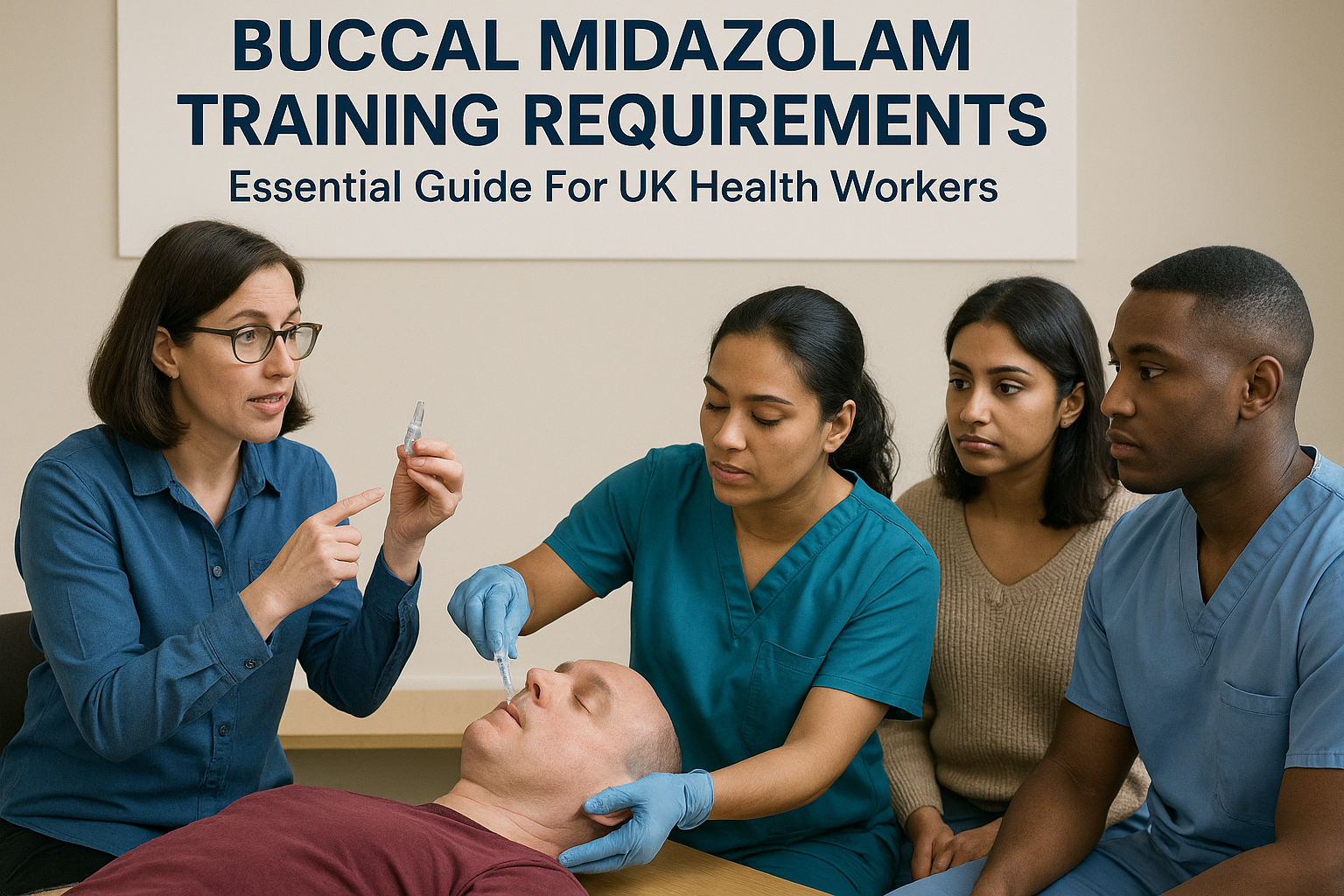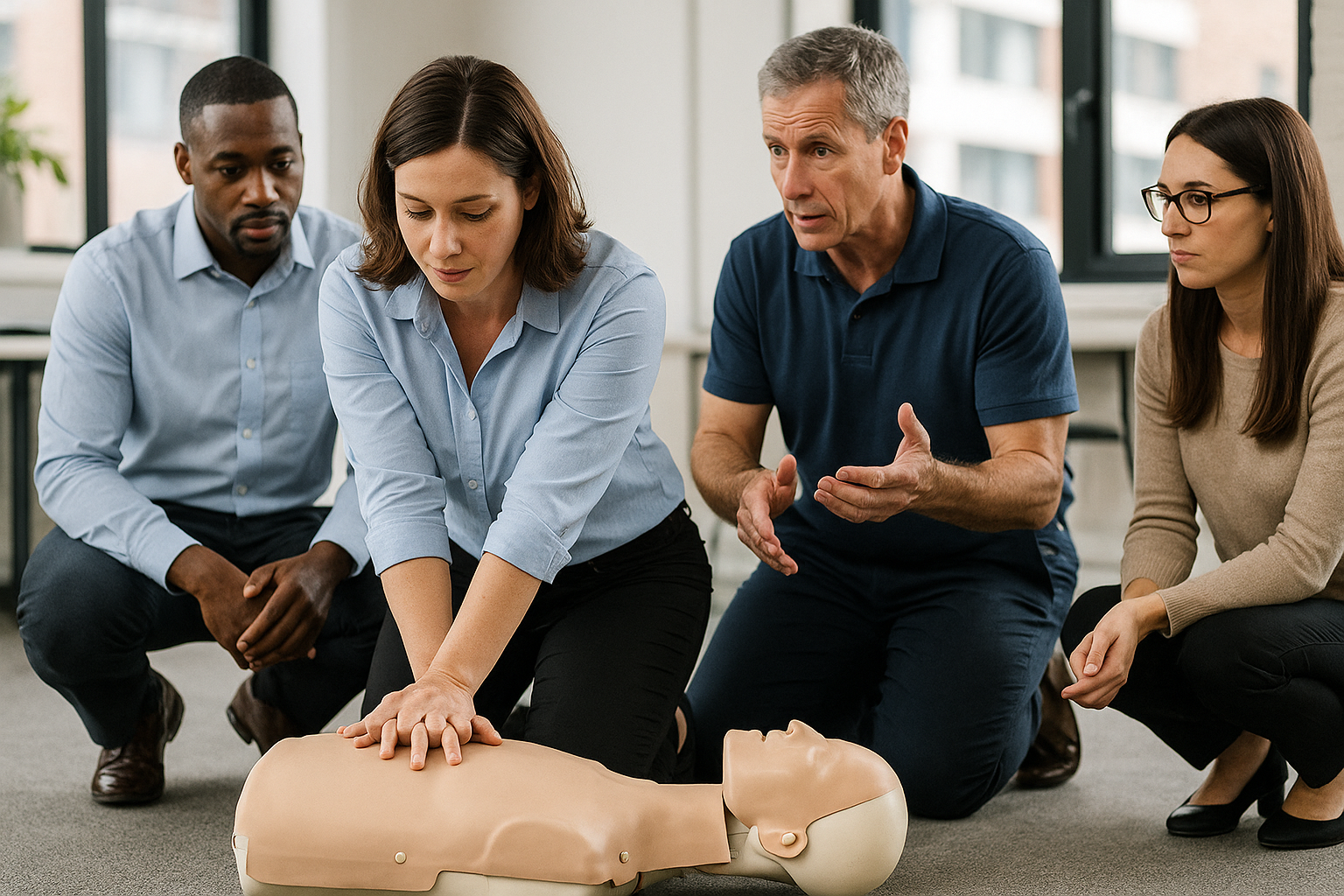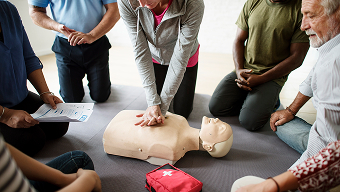Ligature Prevention Training – UK Industry Standards


Ligature Prevention Training - UK Industry Standards
When someone discovers a colleague or service user in a ligature incident, the next 60 seconds determine whether that person survives. Staff who've practiced with actual cutting tools and realistic scenarios respond faster and more effectively than those who've only read about warning signs or watched videos.
Ligature prevention training teaches healthcare workers, care home staff, and facilities teams how to identify risks, use emergency equipment, and provide immediate medical care during self-harm incidents. This guide covers UK regulatory requirements, practical response protocols, and how to select training that builds genuine competency rather than just ticking compliance boxes.
What is ligature prevention training?
Ligature prevention training teaches staff how to spot potential risks, respond to self-harm emergencies, and use specialized cutting tools to save someone's life. The training goes beyond basic awareness courses by giving participants hands-on practice with actual emergency equipment and realistic scenarios led by paramedics or mental health professionals who've managed these situations before.
A ligature is any material someone uses to compress their neck—clothing, bedsheets, cords, or even shoelaces. In mental health units, care homes, and secure facilities, staff encounter these critical incidents and require practical skills, not just theoretical knowledge about warning signs.
Definition in mental health and custodial contexts
A ligature incident happens when someone uses any object to restrict blood flow or breathing by compressing their neck. In healthcare settings, this represents one of the most serious risks to patient safety, particularly for individuals experiencing mental health crises, severe depression, or acute emotional distress.
Mental health trusts and secure hospitals conduct regular environmental audits to find potential ligature points—any fixed object that could support a person's weight. Even after removing obvious risks, staff still need emergency response skills because eliminating every possible attachment point remains impossible without compromising dignity and quality of life.
Difference between awareness and prevention courses
Awareness training covers risk identification and behavioral warning signs through classroom discussion or online modules. Prevention training adds physical intervention techniques, hands-on cutter practice, post-incident medical care, and proper documentation for inspections.
Many organizations start everyone with awareness courses, then provide prevention training to staff working directly with high-risk individuals. The distinction matters for compliance—regulators like the Care Quality Commission expect frontline mental health staff to demonstrate practical competency, not just theoretical understanding.
Why ligature prevention matters in UK workplaces
Organizations caring for vulnerable individuals carry legal and moral responsibility to protect service users from avoidable harm. When staff lack proper training, the consequences include potential loss of life, regulatory enforcement action, criminal investigations, and civil liability claims.
The Care Quality Commission regularly cites inadequate ligature risk management during inspections, particularly after serious incidents. Providers with gaps in this area face enforcement notices, conditional ratings, or service suspension until they demonstrate improvement.
Human impact and legal consequences
Every ligature incident represents a failure in duty of care. Beyond the immediate tragedy, events create lasting trauma for responding staff, families who lose loved ones, and other service users who experience the aftermath.
Under the Health and Safety at Work Act 1974, employers carry responsibility for staff competency to manage reasonably foreseeable risks. After serious incidents, the Health and Safety Executive investigates whether training provisions were adequate, and prosecutors have pursued corporate manslaughter charges in cases where systemic failures contributed to preventable deaths.
Common ligature points identified in audits
Environmental risk assessments consistently identify certain fixtures as high-risk attachment points:
- Door handles and hinges: Particularly in bathrooms and bedrooms where individuals have privacy
- Bathroom fixtures: Towel rails, shower heads, grab bars, and exposed pipework
- Window fittings: Curtain rails, window handles, and restrictors
- Furniture edges: Bed frames, chair backs, wardrobe rails at heights enabling attachment
- Heating and ventilation: Radiator pipes, air conditioning units, ceiling vents with accessible grilles
Even after removing obvious risks, staff vigilance remains essential because individuals in crisis can improvise ligatures from seemingly harmless objects.
UK standards and regulations governing ligature safety
Multiple regulatory frameworks create overlapping requirements for ligature risk management, making comprehensive staff training a legal necessity for many organizations. Understanding which standards apply to your setting helps ensure your training program meets all relevant compliance obligations.
CQC fundamental standards
The Care Quality Commission's Fundamental Standards require registered providers to protect service users from abuse and improper treatment, including self-harm. Regulation 12 addresses safe care and treatment, which includes having appropriately trained staff who can identify and respond to ligature risks.
During inspections, CQC assessors review training records, observe staff knowledge, and examine how organizations respond to incidents. Providers rated as "Requires Improvement" or "Inadequate" often show gaps in staff competency around risk assessment and emergency response.
NICE NG10 and NG27 guidance
The National Institute for Health and Care Excellence publishes clinical guidelines informing best practice across the NHS and private healthcare. NICE NG10 addresses violence and aggression management in mental health settings, while NG27 focuses on self-harm assessment and intervention.
Both guidelines emphasize environmental safety measures combined with staff training that enables confident, compassionate response to individuals in crisis.
HSE duties under HSWA 1974
The Health and Safety Executive expects employers to conduct thorough risk assessments identifying potential hazards to service users and staff. Where ligature risks exist, employers implement control measures including competent staff capable of managing risks effectively.
Section 2 of the Health and Safety at Work Act creates a duty to provide whatever information, instruction, training, and supervision is necessary to ensure health and safety.
Mental Health Act code of practice highlights
The Mental Health Act Code of Practice provides statutory guidance for organizations detaining patients under the Act. Chapter 26 addresses safety in mental health units, including requirements for ligature risk assessment and mitigation strategies.
Hospitals and independent mental health providers demonstrate compliance with Code of Practice standards, which include ensuring staff have knowledge and skills to maintain safe environments and respond appropriately to self-harm incidents.
Who needs ligature training and when
Not every workplace requires ligature prevention training, but certain sectors face clear regulatory expectations and heightened duty of care obligations. Understanding whether your organization falls into high-risk categories helps determine appropriate training investments.
Mental health and learning disability services
NHS mental health trusts, independent hospitals, and community mental health teams working with individuals experiencing acute mental illness carry the highest obligation for comprehensive ligature training. Staff in psychiatric intensive care units, acute wards, and crisis houses encounter elevated risks daily and require regular skills refreshers.
Learning disability services supporting individuals with co-occurring mental health conditions or histories of self-harm also fall into this category, particularly residential settings where staff provide 24-hour care.
Care homes supported living and FM contracts
Residential care homes for older adults, particularly those with dementia or depression, increasingly recognize ligature risks among their resident populations. Supported living schemes for adults with complex needs similarly require staff training proportionate to risks present in their service user group.
Facilities management companies maintaining contracts with healthcare providers or custodial services often include ligature awareness and response capabilities in their service specifications.
Corporate offices with high-risk areas
Some corporate environments implement ligature training for wellbeing teams, first aiders, or security personnel, particularly in organizations with known employee mental health concerns. This represents a proactive approach to duty of care beyond minimum legal requirements.
Core skills and learning outcomes
Effective ligature prevention training develops specific practical competencies staff can deploy immediately during real incidents. The best courses balance technical skills with emotional intelligence needed to respond compassionately during distressing situations.
Dynamic ligature risk assessment
Participants learn to conduct rapid environmental scans identifying potential ligature points in any setting, considering both obvious fixtures and improvised arrangements individuals in crisis might create. Training covers how different materials—fabric, cables, rigid objects—present varying risk levels and require different response approaches.
Staff practice assessing urgency levels to determine whether immediate intervention is necessary or whether they can safely summon additional support first.
Safe use of emergency cutting tools
Hands-on practice with specialized ligature cutters forms the core of prevention training. Participants learn proper grip techniques, optimal cutting angles, and how to support a person's weight while removing constriction to prevent sudden collapse or additional injury.
Different cutter types suit different materials—ring cutters for narrow cords, trauma shears for fabric ligatures, specialized tools for rigid materials. Training includes understanding each tool's capabilities and limitations so staff select the right equipment in urgent situations.
Post-incident medical and debrief protocols
Once a ligature is removed, staff immediately assess for breathing, pulse, and consciousness while positioning the person safely and summoning emergency medical services if needed. Training covers basic life support principles specific to ligature incidents, including potential complications like laryngeal injury or delayed airway swelling.
Courses also address psychological first aid for the individual who experienced the crisis, support for staff members who responded, and proper incident debrief procedures that help teams learn from events without creating blame cultures.
Documentation for inspectors
Regulatory inspections following serious incidents scrutinize documentation quality closely. Training teaches staff what information to record immediately, how to preserve evidence without compromising care, and which notifications to make to managers, safeguarding teams, and external bodies like the CQC or local authority.
Step-by-step response to a ligature incident
When staff discover someone in a ligature incident, following a clear protocol helps manage the intense pressure of emergencies. Training drills the steps until they become automatic, reducing hesitation that could cost precious seconds.
1. Assess scene safety
Before approaching, quickly check whether the environment presents immediate danger—aggressive behavior, unstable furniture, or other hazards. This assessment takes only seconds but prevents rescuers from becoming additional casualties.
2. Call for help and start clock
Immediately alert colleagues using your workplace communication system—emergency alarms, radio calls, or verbal shouts—and note the time. Other staff can summon emergency services while you begin intervention, and accurate timing helps medical professionals understand how long the person experienced restricted blood flow.
3. Remove or relieve pressure
Using appropriate cutting tools, sever the ligature material at a point allowing quick removal while supporting the person's weight to prevent sudden falls. If cutting isn't immediately possible, manually relieving pressure by lifting or supporting body weight can restore blood flow until tools arrive.
4. Provide immediate medical aid
Once the ligature is removed, check for breathing and pulse, beginning CPR if necessary. Position an unconscious but breathing person in the recovery position and monitor closely for changes while emergency services are en route.
5. Complete incident report and debrief
After the immediate crisis resolves and the person receives appropriate medical care, complete thorough documentation while details remain fresh. Participate in team debriefs examining what happened, how the response went, and what improvements might prevent future incidents.
Using and maintaining ligature cutters safely
Emergency cutting tools only function effectively when properly maintained and readily accessible during crises. Organizations balance security concerns with urgent access requirements of emergency situations.
Selection criteria
Different cutting tools suit different environments and risk profiles:
- Ring cutters: Excel at removing jewelry or narrow cords but struggle with thick fabric
- Trauma shears: Handle clothing and bedding effectively but may not cut rigid materials
- Specialized ligature cutters: Combine features from multiple tool types for unpredictable situations
When selecting equipment, consider the materials most likely present in your environment and ensure staff train with the exact tools they'll use during real incidents.
Routine checks and storage
Weekly equipment audits verify that ligature cutters remain in assigned locations, blades stay sharp, and any used or damaged tools get replaced promptly. Storage locations balance security with rapid availability during crises—many organizations use secure cabinets with break-glass access or coded locks that trained staff can open quickly.
Practice drills for speed
Regular skills rehearsal using training materials maintains proficiency and builds muscle memory that helps staff act decisively under extreme stress. Quarterly practice sessions using simulated ligatures on mannequins keep cutting techniques sharp and identify any staff members who need additional coaching.
How we deliver on-site ligature training for up to 12 staff
Kasorb brings ligature prevention training directly to your workplace, using your actual environment to create realistic scenarios preparing staff for specific situations they might encounter in your facility. Our flat-rate group pricing covers up to 12 participants.
Interactive scenarios led by paramedics
Our instructors bring frontline emergency response experience—paramedics, ER nurses, and mental health professionals who've managed real ligature incidents. They guide participants through realistic simulations building both technical skills and emotional resilience needed to act effectively during actual emergencies.
Hands-on use of real equipment
Every participant practices with actual ligature cutters and emergency response tools, not just demonstrations or videos. We bring professional-grade equipment to your site and ensure everyone gains confidence through repeated practice on various materials and scenarios.
Digital certificates issued same day
Participants receive secure digital certificates immediately upon course completion, with credentials including unique verification codes for regulatory inspections. Your compliance records update instantly, eliminating administrative delays and ensuring you can demonstrate current staff competency whenever inspectors visit.
Accreditation certification and CPD hours explained
Understanding what different training certifications mean helps you select courses satisfying your specific regulatory requirements and professional development obligations. Not all ligature training carries equal recognition from regulators and professional bodies.
Recognized bodies and evidence for CQC
The Care Quality Commission doesn't mandate specific training providers but expects evidence that staff training is comprehensive, regularly refreshed, and delivered by competent instructors. Certificates from organizations with relevant healthcare accreditation carry more weight during inspections than generic certificates from unaccredited providers.
When selecting training, verify that certificates include sufficient detail about course content, duration, and learning outcomes to satisfy regulatory scrutiny.
CPD allocation and record keeping
Most ligature prevention courses award between 3-6 hours of Continuing Professional Development credit, depending on course length and depth. Healthcare professionals registered with bodies like the Nursing and Midwifery Council can count training toward their revalidation requirements, provided they maintain proper records.
Organizations maintain centralized training matrices tracking when each staff member completed ligature training, when refreshers are due, and which version of protocols they trained under.
How often to refresh ligature training
Skills deteriorate without regular practice, and organizational procedures evolve as you learn from incidents and near-misses. Establishing appropriate refresher intervals ensures staff competency remains current while avoiding unnecessary training costs.
Annual recommendations from CQC
The Care Quality Commission typically expects annual refresher training for critical safety skills like ligature response, particularly in mental health settings where incidents represent foreseeable risks. Some high-risk environments implement six-monthly refreshers to maintain heightened readiness, especially for staff in acute or intensive care units.
Trigger events that demand immediate re-training
Certain situations require prompt refresher training outside regular schedules. Following any ligature incident—even near-misses where no harm occurred—teams benefit from reviewing their response, identifying any gaps in execution, and practicing improved techniques while the experience remains fresh.
Similarly, when new equipment is introduced, facility layouts change significantly, or staff express concerns about their confidence levels, organizations arrange immediate refresher sessions rather than waiting for scheduled annual updates.
Ready to protect your team with Kasorb
Ligature prevention training represents one of the most critical investments organizations can make in protecting vulnerable individuals and supporting staff who carry the weight of keeping people safe. Kasorb's practical, hands-on approach ensures your team gains genuine competency, not just certificates.
Book your on-site ligature prevention training now and give your team the practical skills they need to respond effectively when it matters most.
Frequently asked questions about ligature prevention training
Does ligature training count toward mandatory CSTF hours?
Yes, ligature prevention training typically contributes to Core Skills Training Framework requirements as it addresses essential safety competencies for healthcare workers. The specific CPD hours awarded depend on course duration and content depth, but most comprehensive courses provide 3-6 hours counting toward annual CSTF obligations.
How long is a ligature prevention certificate valid?
Most certificates remain valid for 12 months, though some organizations require refresher training every 6 months depending on risk levels in their specific environments. High-risk settings like psychiatric intensive care units often implement more frequent refreshers to maintain heightened staff readiness.
Can temporary agency staff join an on-site course?
Yes, agency workers can participate in group training sessions as long as total participants don't exceed 12 people per course. Including agency staff in your training ensures consistent competency across your entire workforce regardless of employment status.
What paperwork do I show inspectors after training?
Present digital certificates, attendance records, and competency assessments as evidence of staff training compliance during regulatory visits. Inspectors also appreciate seeing your training matrix tracking when each staff member completed training and when refreshers are due.


Book a free 15-min consult call with us. We’ll help you get your mandatory training done right.





